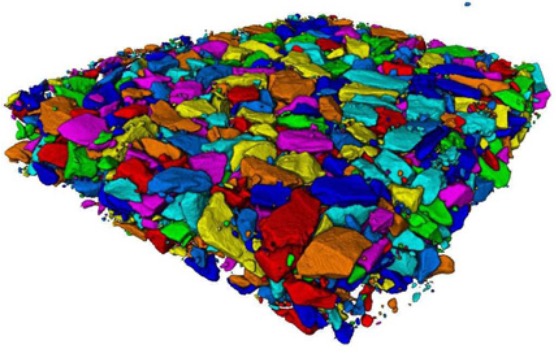Thermal management is one of the crucial issues in the development of magnetocaloric refrigeration technology for application. In order to ensure optimal exploitation of the materials “primary” properties, such as entropy change and temperature lift, thermal properties (and other “secondary” properties) play an important role. In magnetocaloric composites, which show an increased cycling stability in comparison to their bulk counterparts, thermal properties are strongly determined by the geometric arrangement of the corresponding components. In the first part of this paper, the inner structure of a polymer-bonded La(Fe, Co, Si)13-composite was studied by X-ray computed tomography. Based on this 3D data, a numerical study along all three spatial directions revealed anisotropic thermal conductivity of the composite: Due to the preparation process, the long-axis of the magnetocaloric particles is aligned along the xy plane which is why the in-plane thermal conductivity is larger than the thermal conductivity along the z-axis. Further, the study is expanded to a second aspect devoted to the influence of particle distribution and alignment within the polymer matrix. Based on an equivalent ellipsoids model to describe the inner structure of the composite, numerical simulation of the thermal conductivity in different particle arrangements and orientation distributions were performed. This paper evaluates the possibilities of microstructural design for inducing and adjusting anisotropic thermal conductivity in magnetocaloric composites.

Thermal management is one of the crucial issues in the development of magnetocaloric refrigeration technology for application. In order to ensure optimal exploitation of the materials “primary” properties, such as entropy change and temperature lift, thermal properties (and other “secondary” properties) play an important role. In magnetocaloric composites, which show an increased cycling stability in comparison to their bulk counterparts, thermal properties are strongly determined by the geometric arrangement of the corresponding components. In the first part of this paper, the inner structure of a polymer-bonded La(Fe, Co, Si)13-composite was studied by X-ray computed tomography. Based on this 3D data, a numerical study along all three spatial directions revealed anisotropic thermal conductivity of the composite: Due to the preparation process, the long-axis of the magnetocaloric particles is aligned along the xy plane which is why the in-plane thermal conductivity is larger than the thermal conductivity along the z-axis. Further, the study is expanded to a second aspect devoted to the influence of particle distribution and alignment within the polymer matrix. Based on an equivalent ellipsoids model to describe the inner structure of the composite, numerical simulation of the thermal conductivity in different particle arrangements and orientation distributions were performed. This paper evaluates the possibilities of microstructural design for inducing and adjusting anisotropic thermal conductivity in magnetocaloric composites.
